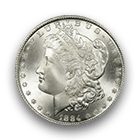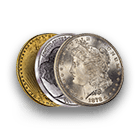The world of numismatic varieties is filled with oddities, anomalies, and curiosities of all sorts, including die clashes, abraded dies, die cracks, die breaks, and more. Yet one type of variety is far above the rest in popularity: the doubled die. Amazingly, even many folks who don’t consider themselves full-fledged numismatists tend to know about doubled dies – often, referred to by the common malapropism, “double dies.”
A doubled die occurs when the die, which is the implement that strikes a design onto a blank coin (planchet) at the Mint, features doubling of its design or lettering. “Dies are created by cutting the coin’s design into the end of a steel bar, pressing this bar into a cone-shaped piece of metal in order to transfer the design to it, then using this piece of metal (now a die) to press additional dies,” explains PCGS Senior Researcher and Variety Specialist Edward Van Orden. “For many years, dies required multiple pressings to produce a sharp image. Doubled (as well as tripled and quadrupled) dies are created when the die alignment of each pressing is not perfectly aligned with any of the other pressings.”
Determining whether or not one has a doubled die in one’s possession frequently leads to a great deal of confusion for many people, especially because there are other mint-caused aberrations that may mimic the appearance of a doubled die. Among other errors that result in the doubling of design details are double strikes and machine doubling.
“Doubled dies will produce the exact doubling on every coin they strike,” says Van Orden. “Double strikes happen when a planchet is struck but fails to eject and receives another strike. Machine doubling happens when the die moves or ‘bounces’ due to its looseness within the coin press, creating what appears to be a doubled image. These die bounces are slightly different every time, so the ‘doubling’ of each coin will be unique.”
While doubled dies have been produced by the U.S. Mint going back to the 19th century, they really only gained traction as a popular collectible with the discovery of the 1955 Doubled Die Obverse Lincoln Cent. The coin happened to hit the scene just as numismatics was enjoying its zenith of popularity in America, therefore, millions of people were aware of the coin and looking for it in circulation. “Doubled dies are unusual, not something you see every day, and perhaps they stimulate the observer’s curiosity as to how they came to be,” Van Orden remarks. “Additionally, they are usually scarce to very rare relative to the number of correctly produced coins and can be exceptionally valuable.”
It’s important to note, however, that not all doubled dies are considered valuable by the market. While coins like the 1955 Doubled Die Obverse Lincoln Cent command more than $1,000 even in well-worn grades, it takes a certain kind of doubled die to really become a huge numismatic hit. Many doubled dies come along with doubling too minute or obscure to attract much attention. It’s pieces like the 1955 Doubled Die Obverse Lincoln Cent, with its drastic replication of the lettering and other details on the front of the coin, that create headlines. “In general, if die doubling is visible to the naked eye, anyone can see it, whether or not they are a numismatist. So, it will have a potentially larger audience interested in it.”
Van Orden goes on to say that, “Coins made from doubled dies (as well as double strikes) are always, for me, a pleasant surprise to see and even more so to happen upon. Learning the characteristics of these in order to differentiate them from machine doubling is an essential first step to correctly identifying which you are looking at.”
There are many doubled die coins for collectors to pursue. However, we are focusing on seven of the most important among the Lincoln Cents – a series that has gained much attention in recent months with the news that the cent is targeted for elimination by the United States government. While the future of the cent hangs in the balance, coin collectors, both novice and seasoned, have been giving the culturally iconic “penny” much extra attention lately.
1955 Doubled Die Obverse Lincoln Cent
There are few doubled dies as popular as the 1955 Doubled Die Obverse Lincoln Cent, the coin that many say started the craze for doubled dies and other die varieties. These pieces caused a stir when they started showing up during the height of the American numismatic boom in the 1950s. They were sometimes encountered as change wrapped in 23-cent packs of cigarettes, sold in vending machines that accepted only quarters. “Since 1955 Doubled Dies were being found the same year in which they were released, many coins were pulled aside and preserved,” writes PCGS Price Guide Editor Jaime Hernandez for PCGS CoinFacts. “Because of this, most coins exist in AU grades and higher,” he concludes.
While approximately 24,000 examples may have escaped the Philadelphia Mint, many were lost in circulation. PCGS pegs the figure at approximately 15,000. As of the date of this issue, an example fetches around $2,300 in AU50, with prices leaping into the $4,000 territory for an MS63BN. An MS64RB garners about $9,000, and exceedingly rare MS65RD examples take a whopping $60,000. The record price for the 1955 Doubled Die Obverse Lincoln Cent was hammered in 2018 for a PCGS-graded MS65+RD specimen that crossed the block at a Stack’s Bowers Galleries auction for the astonishing sum of $114,000.
1958 Doubled Die Obverse Lincoln Cent
The undisputed king of all doubled dies (and arguably all Lincoln Cents) is the 1958 Doubled Die Obverse Lincoln Cent. Only three are known, making it by far one of the most elusive doubled die coins in existence. But this isn’t even the kicker.
What blows away most numismatists about this coin is the record price it achieved when the finest example hit the auction block in 2023. That specimen of the 1958 Doubled Die Obverse Lincoln Cent, graded a stellar MS65RD, took home $1,136,250 (with buyer’s fees). The variety, first discovered in the early 1980s, is attributed by heavy doubling in the motto “IN GOD WE TRUST” and legend “LIBERTY.”
1969-S Doubled Die Obverse Lincoln Cent
This very rare doubled die obverse Lincoln Cent offers drastic doubling in the date, the motto “IN GOD WE TRUST,” and the legend “LIBERTY,” but not the “S” mintmark. It’s a seeming quirk that is easily explained by the fact that in the late 1960s, Mint employees hand-punched the mintmarks onto coins after the die was created (and when die doubling would have occurred).
Amazingly, there are many reports of 1969-S Doubled Die Obverse Lincoln Cents being found in circulation, with several being found in ordinary rolls. While it takes an incalculable amount of luck to find one of these doubled dies, it should give everyone reading this hope that some persistent roll searching (or a serendipitous find in a handful of change from the corner convenience store) may land one of these sought-after rarities. An AU50 specimen sells for $14,500, while an MS63BN is worth an incredible $45,000. Prices lurch upward to $70,000 in MS64RB, while an MS65RD could be worth a cool quarter-mil - $250,000 at the time of this writing.
1972 Doubled Die Obverse Lincoln Cent
A major variety of the Lincoln Cent series and broadly viewed as “the” big doubled die among widely collected Lincoln Memorial Cents, the 1972 issue, with its drastically doubled obverse draws collectors far and wide. Strong doubling is present on the date, legend “LIBERTY” and motto “IN GOD WE TRUST,” making it easily visible to the unaided eye.
There are multiple types of doubled dies attributed to this date, making it important to understand the diagnostics for the piece shown here and cataloged as “Type 1” by PCGS. Perhaps the most notable pickup point for the Type 1 doubled die shown here is that the date numerals are doubled to the southwest of all four digits. Examples in MS63BN sell for $375 as of this writing, while in MS65RB, they go for $575. In MS67RD, they can realize $3,250, and one MS67+RD notched $14,400 in a 2019 auction.
This variety is very popular and it is also strong enough to see very easily with the naked eye.
1983 Doubled Die Reverse Lincoln Cent
The only doubled die reverse among the Lincoln Cents included in this guide, the 1983 Doubled Die Reverse Lincoln Cent is considered a major variety and is widely collected. Heavy doubling is seen in the inscriptions “UNITED,” “E PLURIBUS UNUM,” and “ONE CENT.” Notably, this is also the first of the major doubled dies on the zinc-era Lincoln Cents, which were produced with a core of 99.2% zinc and 0.8% copper coated with a pure-copper plating.
Blistering and other production issues can make higher-end examples with attractive surfaces more difficult to locate, a point reflected in the price spread between run-of-the-mill examples and pieces in the better Mint State grades. An example in MS62BN goes for around $90 as of this writing, while an MS65RD can take $550. The record price of $7,050 was paid at auction in 2017 for a PCGS MS68RD example.
1984 Doubled Die Obverse Lincoln Cent
Just a year after the 1983 Doubled Die Reverse Lincoln Cent came to the fore, the 1984 Doubled Die Obverse Lincoln Cent made its appearance. Widely known in the hobby as the 1984 “Doubled Ear” Lincoln Cent, this coin aptly represents its nickname by way of its primary diagnostic: the drastic doubling of Lincoln’s ear.
A close look at the coin quickly reveals the doubled ear lobe, shifted to the south of the primary likeness of Honest Abe’s right auricle. Lincoln’s trademark beard and bowtie also show southward doubling. Many thousands of these coins exist, but the 1984 Doubled Die Obverse Lincoln Cent is no less a major variety and an important collectible. The coin retails for around $85 in MS63BN as of this writing, while MS64RBs take closer to $140. In MS65RD, this doubled-eared variety manages a price of approximately $285. In 2009, an MS68RD realized a record $3,910.
1995 Doubled Die Obverse Lincoln Cent
The 1995 Doubled Die Obverse Lincoln Cent was the most exciting thing to come onto the American numismatic scene in a long time. Bear in mind that U.S. collectors were many years removed from the triumphant appearance of the 1776-1976 Bicentennial coinage, the rise and fall of the Susan B. Anthony Dollar had taken place during the disco era, and the nation had yet to see the spectacles that were to become the 50 State Quarters and Sacagawea “Golden” Dollar around the turn of the 21st century. Yet the 1995 Doubled Die Obverse Lincoln Cent was billed in national news headlines, talked about on the radio, and became one of the earliest major numismatic stories on the fledgling World Wide Web.
Americans set out on pocket change searches, collectors pored through rolls, and everyone enjoyed a bit of doubled die fever when this coin was first discovered early in the year of its production. Examples sold for hundreds of dollars after it was first found, though the coin became more common than first thought and is worth far less today. Still, this is a fascinating die variety that is clearly visible to the unaided eye, with heavy doubling in the motto “IN GOD WE TRUST” and the legend “LIBERTY.” An MS63BN can be had for less than $10 as of this writing, while an MS65RD goes for about $22. A nice MS67RD can be obtained for approximately $115. However, the record price for this modern variety is $5,052.50, which was taken in 2017 by a specimen graded an excellent MS69RD by PCGS.














 Copper & Nickel
Copper & Nickel
 Silver Coins
Silver Coins
 Gold Coins
Gold Coins
 Commemoratives
Commemoratives
 Others
Others
 Bullion
Bullion
 World
World
 Coin Market
Coin Market
 Auctions
Auctions
 Coin Collecting
Coin Collecting
 PCGS News
PCGS News